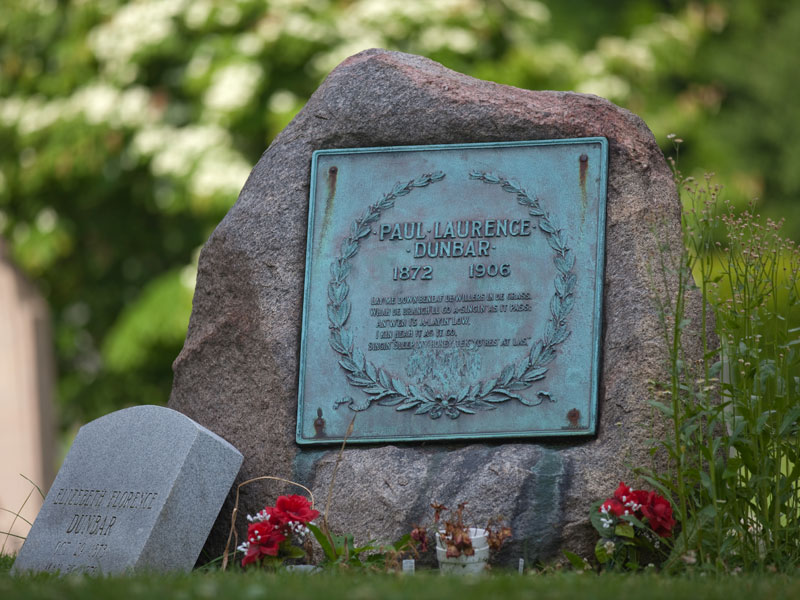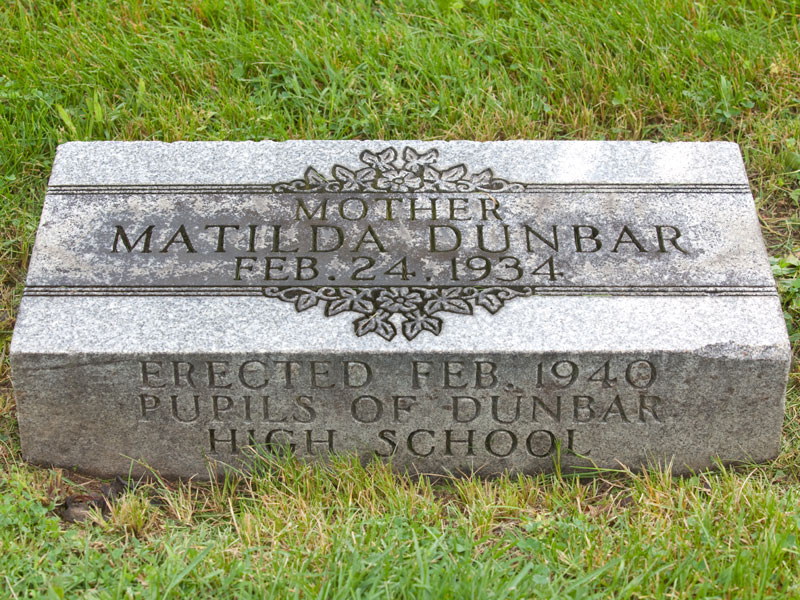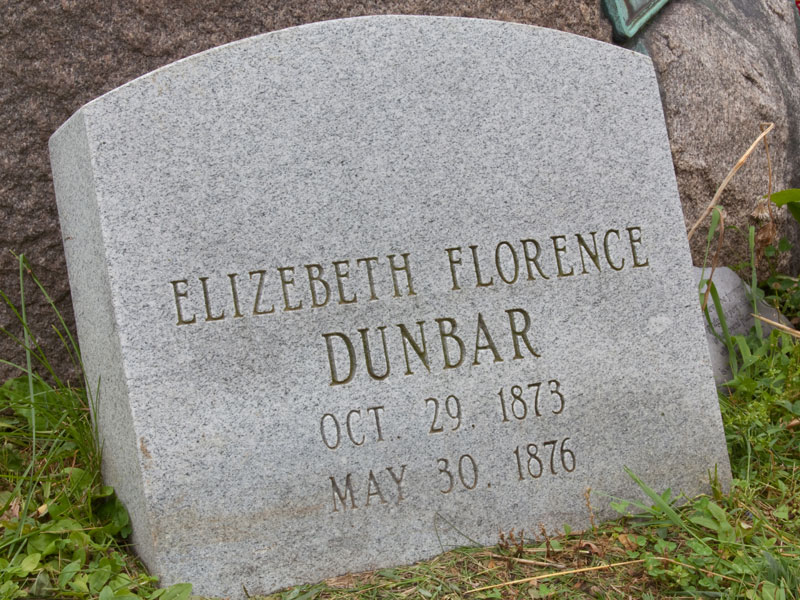On June 26, 1909, a new gravestone for Paul Laurence Dunbar was dedicated at Woodland Cemetery in Dayton. After Paul's death in 1906, he was buried in a low-lying area of Woodland near the Wyoming Street gate (Section 111, Lot 3075). In 1909, his grave was moved to its current location high on a hill (Section 101, Lot 3465). The Paul Laurence Dunbar Memorial Association raised funds to purchase a granite boulder and bronze plaque for the grave.
At a meeting of the Paul Laurence Dunbar Memorial Association, held this day, the following resolutions were unanimously adopted: purchase Lot 3465, in Section 101, in the Woodland Cemetery, to provide for the burial of the remains of the distinguished poet, Paul Laurence Dunbar, and for the erection of a suitable monument to his memory; also for the perpetual care of the same, and memorial exercises at the dedication of the monument. No burials shall be permitted in said lot, except for the remains of Paul Laurence Dunbar and his devoted mother, Mrs. Matilda J. Dunbar.
Charles W. Dustin to Matilda Dunbar, December 22, 1908. Paul Laurence Dunbar Papers, Ohio History Connection (Microfilm edition, Roll 2).
Beneath the typed letter is a handwritten postscript from Charles Dustin, a lawyer and judge in Dayton and chairman of the Memorial Association: "The lot above described is held by me in trust for the purposes and under the conditions named in the above resolutions." Dustin later transferred to lot to Matilda.
C. W. Dustin, Tr. to Matilda J. Dunbar, $1; PL 3465, Woodland Cem.
"Real Estate Transfers." The Dayton Herald (Dayton, Ohio). May 21, 1910. Page 12.
This is Dunbar day in Dayton. At 3:30pm today at Woodland Cemetery the Dunbar monument was unveiled. The program includes the planting of a willow tree and the presentation of a deed for the lot to the poet's mother. The feature of the occasion will be the music under the direction of Professor Blumenschein, who has set verses of the dead poet to scores to be rendered by the Philharmonic society.
"Monument to Dunbar, Poet, Is Unveiled." The Dayton Herald (Dayton, Ohio). June 26, 1909. Page 1.
The ceremonies in connection with the unveiling of the monument erected in honor of Paul Laurence Dunbar were extremely fine. Think of fifty of Dayton's best white singers uniting in a chorus and singing selections written by Dunbar, and doing so cheerfully and gladly.
"News of 'Buckeyedom.' Ceremonies at Dunbar Monument," by J. G. Robinson. The Freeman (Indianapolis, Indiana). July 3, 1909. Page 2.
Paul's mother Matilda participated in the ceremony, along with William Scarborough, president of Wilberforce University, and James Whitcomb Riley, known as the "Hoosier poet," who was an early source of inspiration and encouragement for Paul.
James W. Riley helped Mrs. Matilda Dunbar, mother of the deceased poet, from her carriage Saturday and conducted her to the platform at the unveiling of her son's monument. The aged woman wept when an unpublished poem of gratitude from her son to his patron poet was read. The monument was unveiled by the poet's favorite nephew, Paul Laurence Dunbar Murphy, aged 9, of Chicago. In compliance with a wish in one of the poet's death songs, a willow was planted Saturday over his grave.
"Riley Lauds Paul Dunbar." The Cleveland Gazette (Cleveland, Ohio). July 3, 1909. Page 1.
I took part in the unveiling of the monument to Paul Laurence Dunbar in the Woodland Cemetery at Dayton, Ohio. I had been invited by the Committee through Judge C. W. Dustin to be the "orator of the day." It was a notable occasion. A large assembly of people, white and black, gathered to do honor to the "sweet singer" of the race. The Dayton papers united in publishing a full and glowing account of the exercises. The two distinctively impressive features of the ceremony were the transfer of the deed of the lot to the mother of Dunbar and the planting of a willow over the place where he lies, as he wished, "Down beneaf de willows in de grass."
The Autobiography of William Sanders Scarborough: An American Journey from Slavery to Scholarship. Edited by Michele Valerie Ronnick. Wayne State University Press (Detroit, Michigan). 2005. Pages 205 - 206.
Paul's grave is marked with a granite boulder and a bronze plate designed by Tiffany & Company. The inscription is the first stanza from Paul's dialect poem "A Death Song." Paul had written a different epitaph and given it to his wife Alice, but she was not involved in the planning of the gravesite.
The monument to be erected over the resting place of Dunbar has arrived in the city from Tiffany's in New York. It is a giant marble block, supermounted by a bronze tablet, on which is placed a verse from the poet's favorite poem, "Death Song."
"Will Unveil Monument to Poet, June 26." The Dayton Herald (Dayton, Ohio). May 22, 1909. Page 1.
Lay me down beneaf de willers in de grass,
Whah de branch'll go a-singin' as it pass.
An' w'en I's a-layin' low,
I kin hyeah it as it go
Singin', "Sleep, my honey, tek yo' res' at las'."
Excerpt from "A Death Song," by Paul Laurence Dunbar. Published in Lyrics of the Hearthside (1899).
A willow tree stands beside Paul's grave, as described in the verse. Matilda Dunbar died in 1934 and was buried beside her son. A small stone in memory of Elizebeth Dunbar (Paul's sister who died at age two) leans against Paul's large boulder, although she was buried elsewhere at Woodland.



